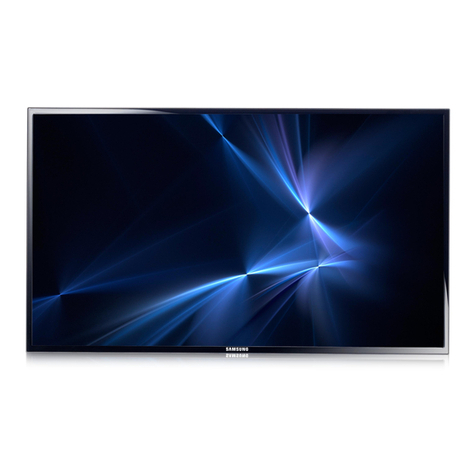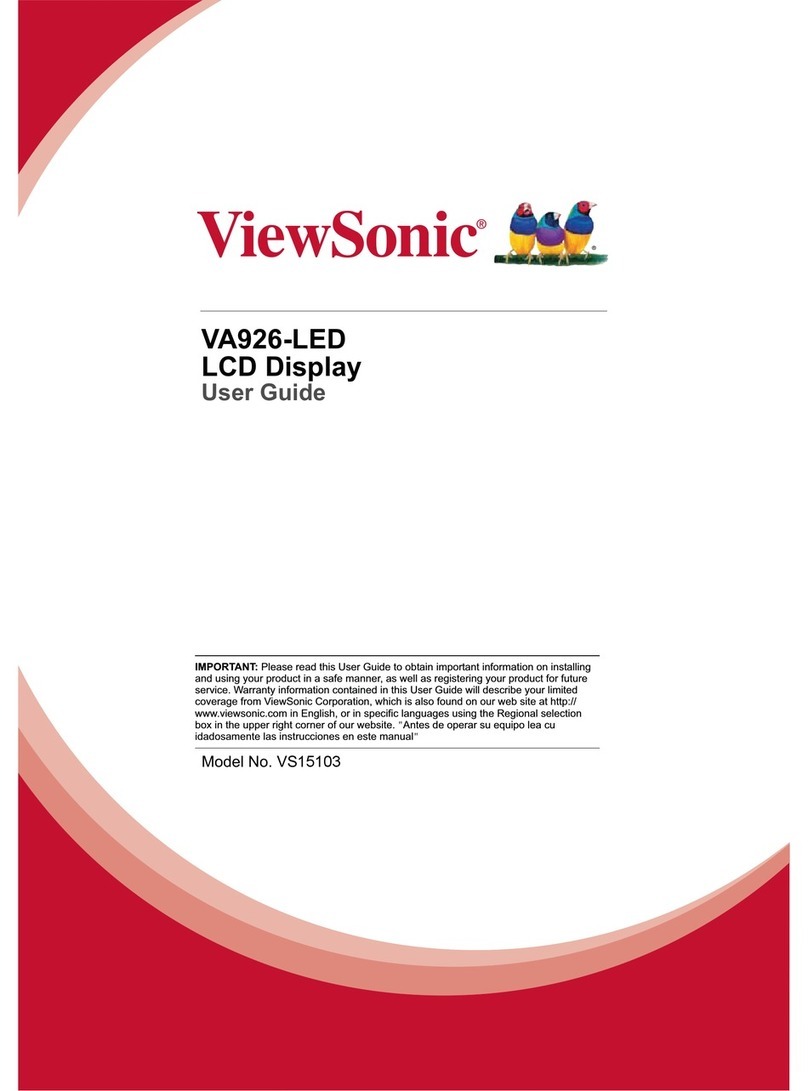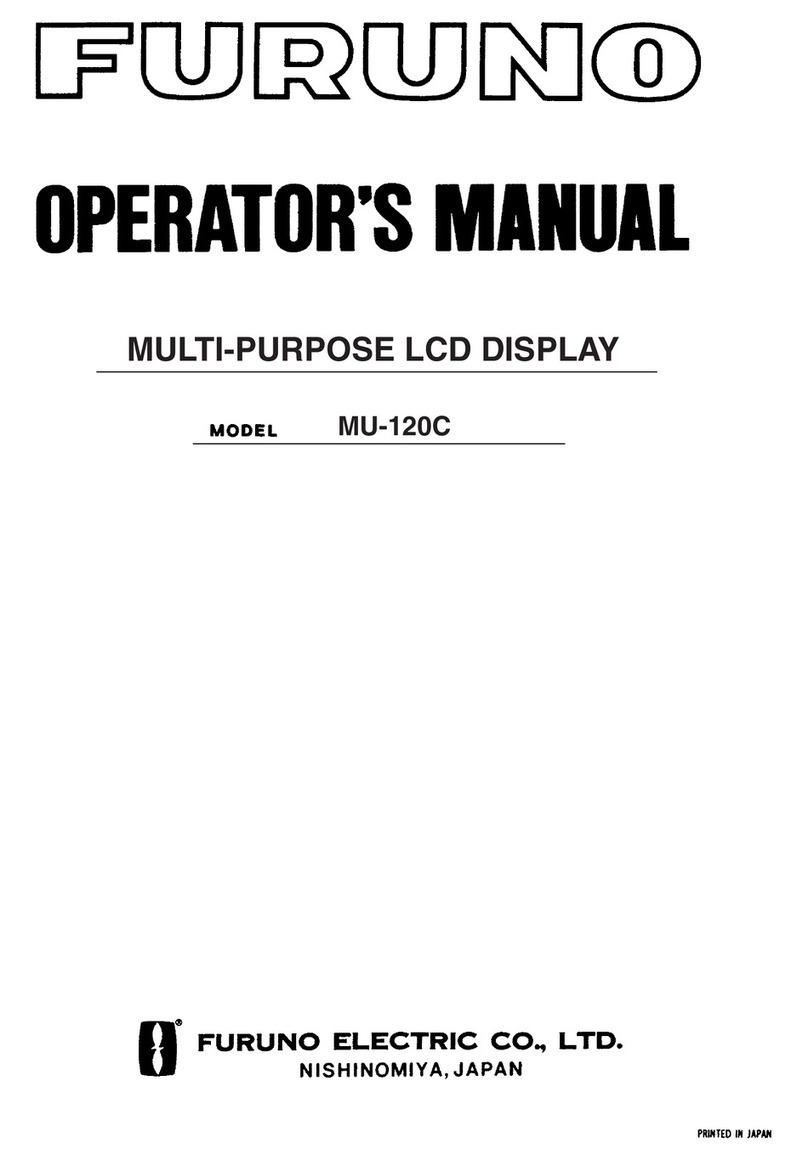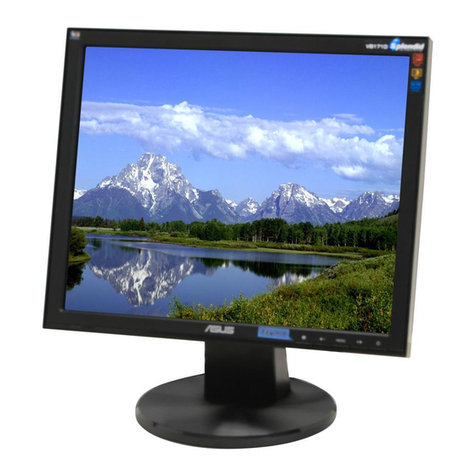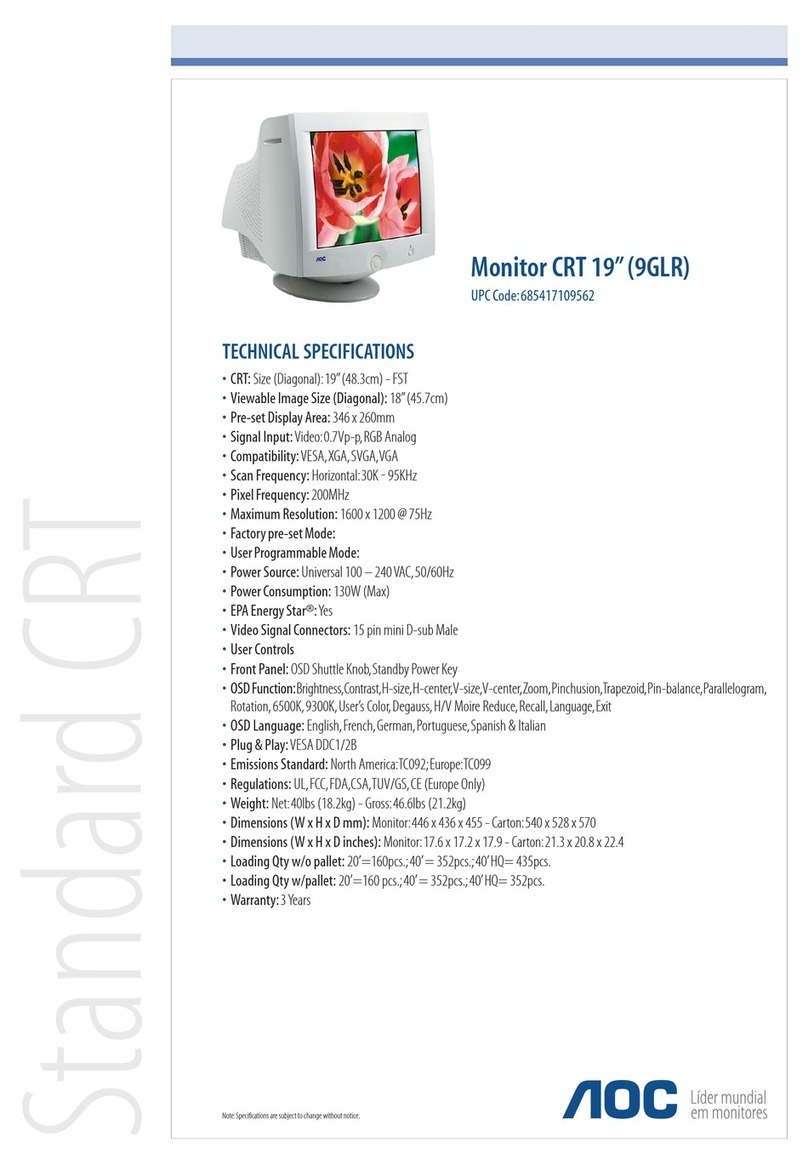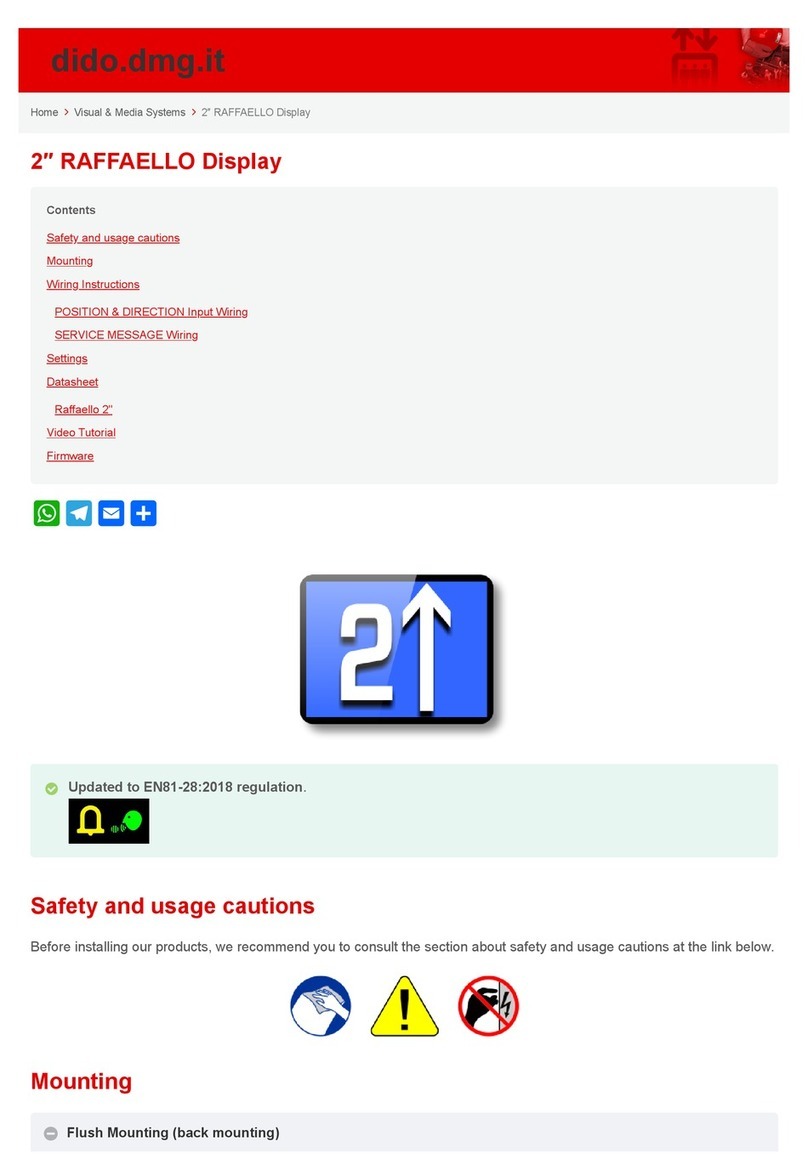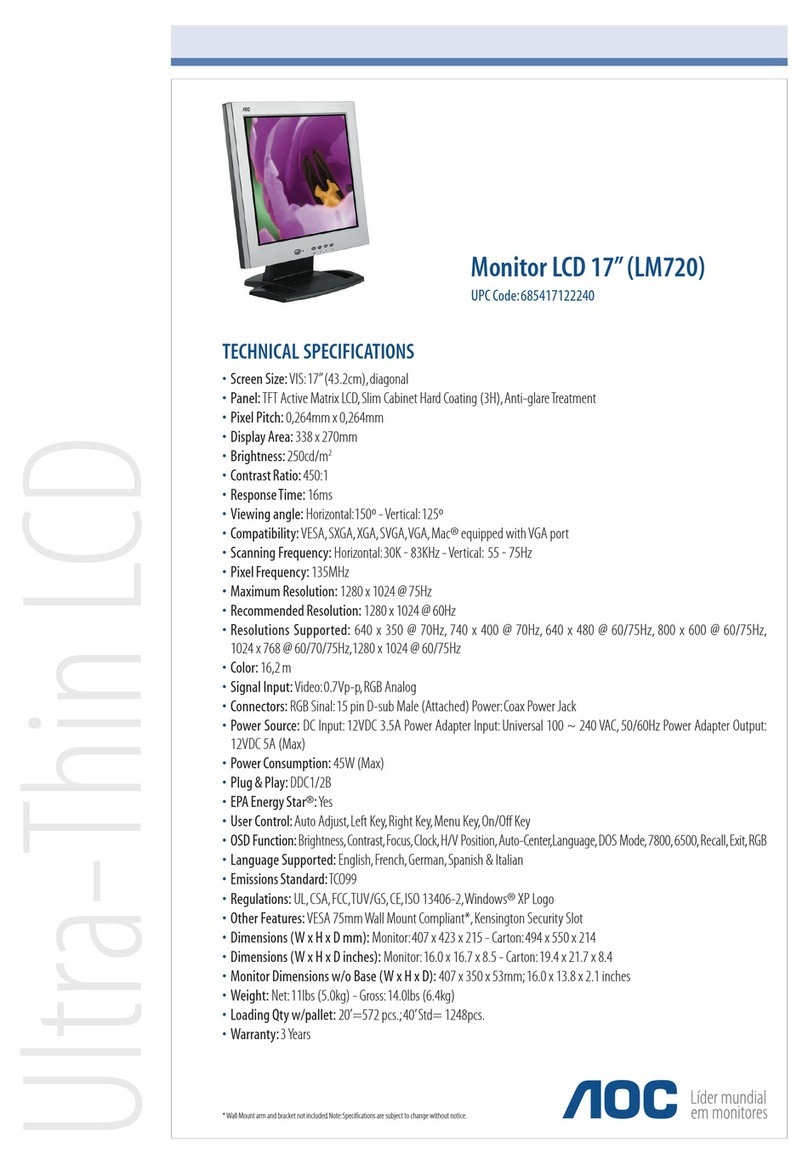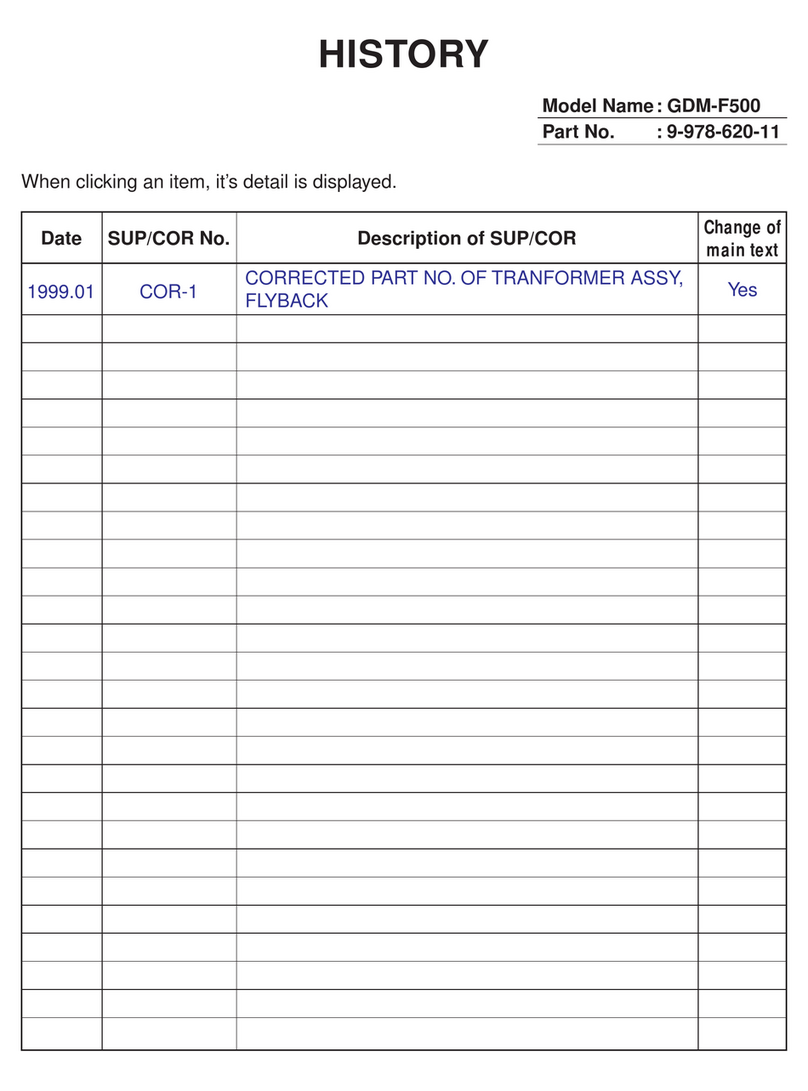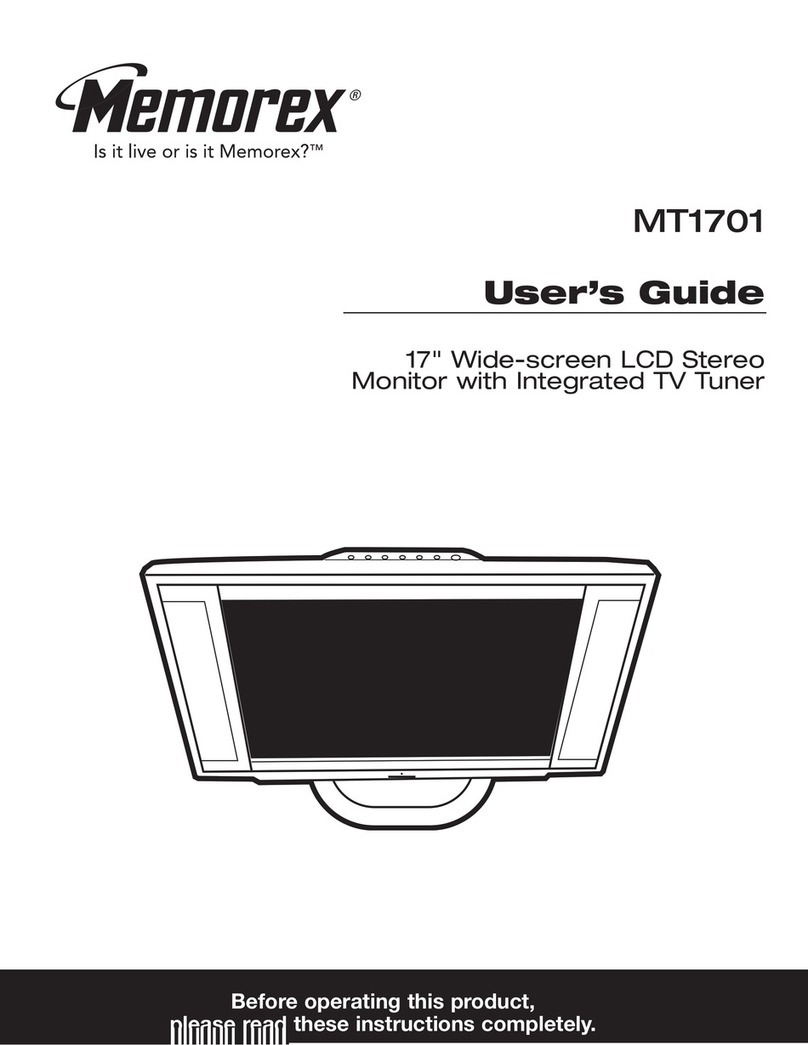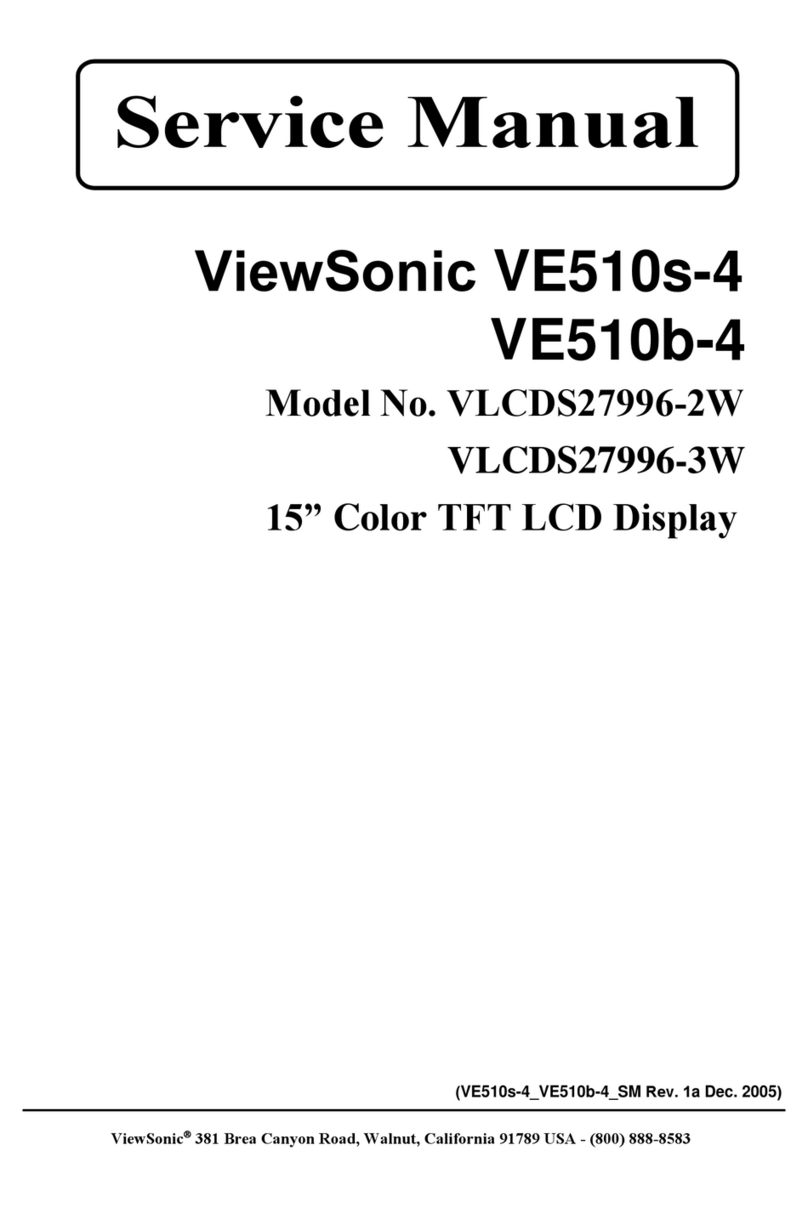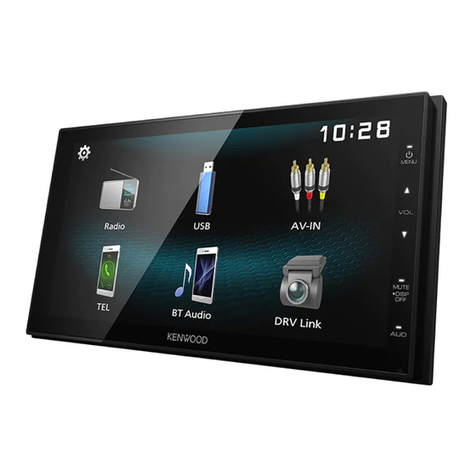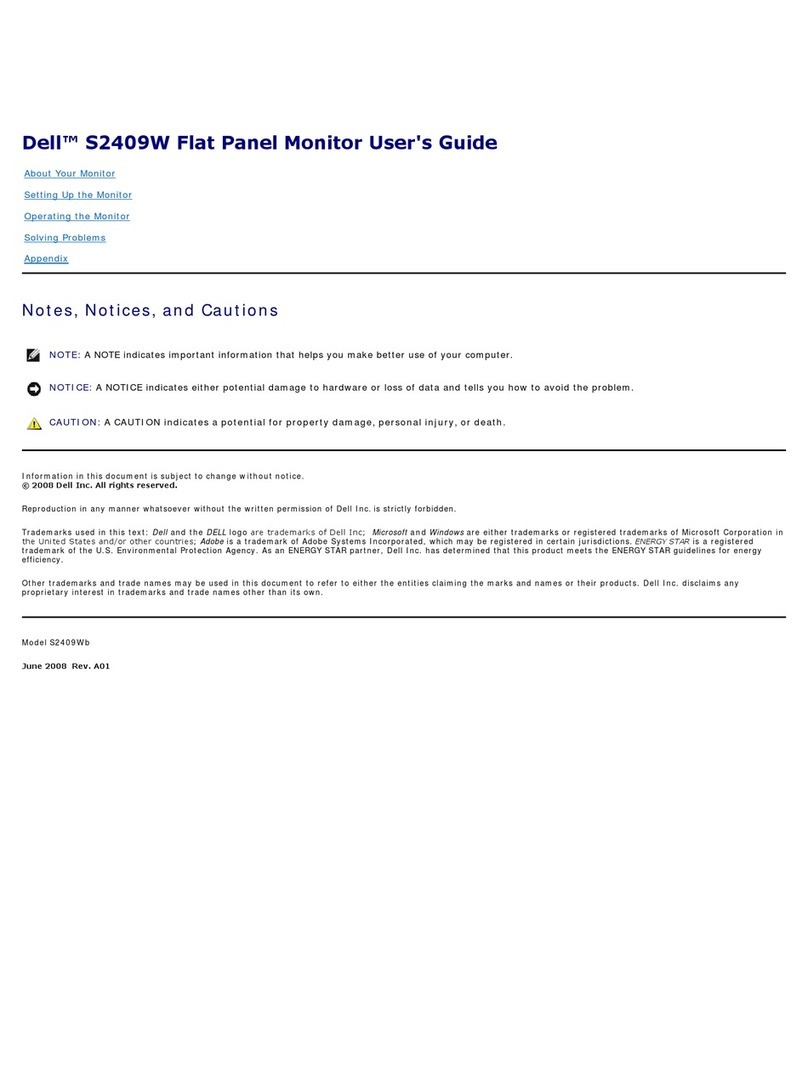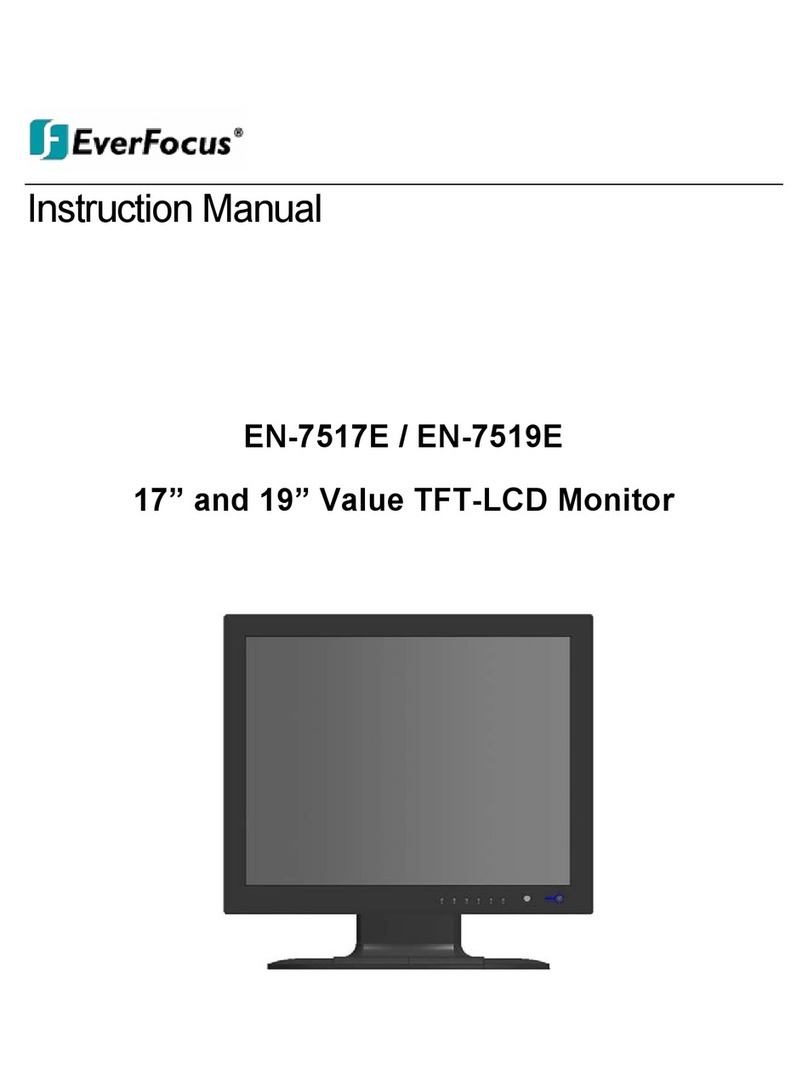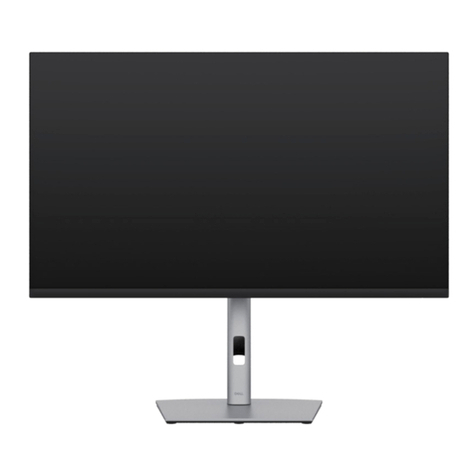TeleVideo 990 User manual

TeleVideo
990
User's Guide

Te/eVideo
990 Video Display Terminal
USER'S GUIDE
Publication
No. 143504-00 Rev. 3
July
1997
Note Change:
TUBE
SIZE 14-inch
(12.0 Inch Diagonal Viewable Area)
CE
Mark Compliance
(Selected Models)
OleleVideo~
2345
Harris
Way
San
Jose
CA 95131
Main
(408) 954-8333
Technical Support
Phone: (408) 955-7711
Fax: (408) 954-0623
E-MAIL
World Wide Web
www.televideoinc.com

Copyright
copyright ©1997 by TeleVideo, Inc. All rights reserved. No part
of
this publication may be reproduced,
transmitted, transcribed, stored in aretrieval system, or translated into any language or computer language,
in any form or by any means, electronic, mechanical, magnetic, optical, chemical, manual, or otherwise,
without the prior written permission
of
TeleVideo, Inc., 2345 Harris Way, San Jose, CA 95131.
Disclaimer
TeleVideo, Inc. makes no representations or warranties with respect to this manual. Further, TeleVideo,
Inc. reserves the right to make changes in the specifications
of
the product described within this manual at
any time without notice and without obligation
of
TeleVideo, Inc. to notify any person
of
such revision or
changes.
Canadian Department
of
Communicatiohs
This digital apparatus does not exceed the class
(AlB,
whichever
is
applicable) limits for radio noise
emission from digital apparatus as set out in the radio interference regulations
of
the Canadian Department
of
Communications.
Le present appareil numerique
n'emet
pas de bruits radioelectriques depassant les Iimites applicables aux
appareils numeriques de classe
(AlB)
(selon de cas) prescrites dans
Ie
reglement sur
Ie
brouillage
radioelectrique edicte par
Ie
ministere des communications du Canada.
FCC Class AWarning
This device
is
classified as aClass Acomputing device. Class Adevices may only
be
used
in
commercial,
business, or industrial environments. This equipment generates, uses, and can radiate radio frequency
energy.
If
not installed and used in accordance with the instruction manual, it may cause interference with
radio emissions. This equipment has been tested and found to comply with the limits for aClass A
computing device, pursuant to Subpart J
of
Part
15
of
FCC Rules, which are designed to provide reasonable
protection against radio frequency interference (RFI) when operated in acommercial environment.
Operation
of
this equipment in aresidential area is likely to cause interference,
in
which case the user at his
own risk and expense will
be
required to correct the interference. The use
of
nonshielded UO cables may
not guarantee compliance with FCC RFI limits.
Trademarks
The following trademarks appear in this publication:
•TeleVideo, 950, 955, and 990 -TeleVideo, Inc.
•WY-60, WY-50, WY-50+, WY-120, WY-150 -Wyse Technology, Inc.
•DEC, VT52, VT100, VT220, VT320 -Digital Equipment Corporation
•IBM, AT, and PS2
-International
Business Machines, Inc.
•SCO -Santa Cruz Operation, Inc.
•Microsoft -Microsoft Corporation
"
ii
USER'S GUIDE

Table
of
Contents
Introduction
About This Manual .....................................vii
Procedural Keystrokes. . . . . . . . . . . . . . . . . . . . . . . . . . . . . . . . . . . . . . . vii
Escape Key Sequences . . . . . . . . . . . . . . . . . . . . . . . . . . . . . . . . . . . . . . vii
Command Code Variables vii
Special Notices . . . . . . . . . . . . . . . . . . . . . . . . . . . . . . . . . . . . . . . . . . vii
Chapter 1INSTALLATION
Preparation .................................
..
I-I
Choosing aSite I-I
Interface Types and Cables I-I
Installation
I-I
Unpacking the Terminal
1-1
Attaching the Keyboard
1-1
Connecting aParallel Printer
I-I
Connecting aSerial Printer
1-1
Host Connections 1-2
Port Pin Assignments . . . . . . . . . . . . . . . . . . . . . . . . . . . . . . . . .
..
1-2
Serial Ports 1-2
COMI Serial Port 1-2
COM2 Serial Port 1-2
Serial Port Verification 1-2
PARALlEL
Port . . . . . . . . . . . . . . . . . . . . . . . . . . . . . . . . . . . . . . . . . 1-3
Plugging In the Terminal .................................. 1-3
Turning On the Power 1-3
Chapter 2SET UP
Parameter Menus . . . . . . . . . . . . . . . . . . . . . . . . . . . . . . . . . . .
..
2-1
Entering Set Up ..........................................2-1
Help Lines 2-2
Command Menu 2-2
Geneml Menu 2-3
Display Menu ...........................................2-4
Keyboard Menu 2-5
COMl
Menu 2-6
COM2 Menu 2-7
Attribute Menu
..
. . . . . . . . . . . . . . . . . . . . . • . . . . . . . . . . . . . . . . . . 2-8
ANSI Menu . . . . . . . . . . . . . . . . . . . . . . . . . . . . . . . . . . . . . . . . . . . . 2-9
Program Menus
2-10
Function Key Logical Sets ................................... 2-10
Editing Key Submenu 2-12
Numeric Pad Submenu 2-13
Answerback Submenu 2-14
Delimiter Submenu 2-15
USER'S GUIDE iii

Chapter 3OPERATION
Starting
Up
.3-1
Adjusting Screen and Keyboard 3-2
Display
Features
. . . . . . . . . . . . . . . . . . . . . . . . . . . . . . . . . . . . . . 3-2
Infonnation
Lines
3-2
Status Line 3-2
User Messages ..........................................3-3
Function
Key
Labels . . . . . . . . . . . . . . . . . . . . . . . . . . . . . . . . . . . . . . . 3-3
Data
Lines
..
.......................................3-3
Number
of
Columns 3-4
Screen-Saver ...........................................3-4
Resetting the
Terminal
...................................3-4
Funct/Alt
Key
3-4
The
FUNCf
Option 3-4
The META Option ........................................3-4
The 3rd LEGEND Option 3-5
The COMPOSE Option. . . . . . . . . . . . . . . . . . . . . . . . . . . . . . : . . . . . . . 3-5
AT
Key
board.
.......................................3-6
Types
of
Keys. ..............................
'.
. . . . . . . . . . . 3-6
Local
Key
Commands ......................................3-6
ASCII
Key
board
............".........................3-8
Types of Keys 3-8
Local
Key
Commands . . . . . . . . . . . . . . . . . . . . . . . . . . . . . . . . . . . . . . 3-8
DEC Style keyboard . . . . . . . . . . . . . . . . . . . . . . . . . . . . . . . . . . . . 3-10
Types
of
Keys. . . . . . . . . . . . . . . . . . . . . . . . . . . . . . . . . . . . . . . .
..
3-10
Local
Key
Commands . . . . . . . . . . . . . . . . . . . . . . . . . . . . .
..
3-10
Serial Communication Modes ...............................
..
3-12
Sending Blocks
of
Data.
. . . . . . . . . . . . . . . . . . . . . . . . . . . . . . . . . .
..
3-12
Editing
Key
Modes.
. . . . . . . . . . . . . . . . . . . . . . . . . . . . . . . . . . . .
..
3-12
Serial
Printer
Control 3-13
Operation with aSerial Printer .............................3-13
Serial Printer Modes . . . . . . . . . . . . . . . . . . . . . . . . . . . . .
..
3-13
Page
Print.
. . . . . . . . . . . . . . . . . . . . . . . . . . . . . . . . . . . . . . . . .
..
3-13
Parallel
Printer
Control 3-14
Parallel Printer Modes . . . . . . . . . . . . . . . . 3-14
Page
Print.
. . . . . . . . . . . . . . . . . . . . . . . . . . . . . . . . . . . . . . . . .
..
3-14
, f
iv USER'S GUIDE

Chapter 4TROUBLESHOOTING
If AProblem Occurs .....................
..
4-1
Troubleshooting Checklist . . . . . . . . . . . . . . . . . . . . . . . . . . . . . . . . . . . . 4-1
Running SelfTest '4-1
Monitor Mode . . . . . . . . . . . . . . . . . . .
'.
. . . . . . . . . . . . . . . . . . . . . . . 4-1
Stand-Alone Test
'.'
4-2
If
You
Need Assistance '. . . . . .
..
4-2
Appendix A
Appendix B
USER'S GUIDE
SPECIFICATIONS
STATUS LINE MESSAGES
v

Introduction
The TeleVideo 990
is
ahigh-performance terminal, designed
to
operate
in
the PC terminal, ASCII, and
ANSI environments, providing considerable flexibility.
It
has also been designed to be user friendly.
You'll find that the terminal
is
very easy to use, with many features that simplify your work.
Keep this manual near the terminal for future reference. The terminal will provide you with many years
of
trouble-free service.
The 990 Terminal
vi
USER'S GUIDE

About
This Manual
This manual
is
organized
as
follows:
•Operation: Installation, setup, daily operation, and problem-solving. Read this por-
tion of the manual. It's wrillen to help you take the best advantage of all the time-
saving and work-saving features of the terminal. Chapters 1-4.
Procedural Keystrokes
Within procedural steps, you will be directed
to
press certain keys. The keys
to
be pressed will be shown
with abox around the keycap legend. For example, the procedure
may
tell you
to
press
!Ctrll B
This means
to
hold down the
Clrl
key
until you press the
~
key.
Similarly, the
Shift
and
AU
keys are simultaneously pressed with other keys.
Escape Key Sequences
The terminal responds
to
escape sequences from the host
or
from the keyboard.
To
enter
an
escape se-
quence from the keyboard, momentarily press the Escape key, then sequentially press the keys for the
string
of
characters shown in the escape sequence.
To
keep the command sequence on alocal basis"
hold down the
Shift
key when you press the Escape key. (An unshifted Escape key sends the command
sequence to the host.)
Command Code Variables
Command codes may have variable values as part
of
the code
to
be entered. Variables are shown in ital-
ics.
For
example,
if
you are directed
to
enter adate,
it
will be shown as mm
dd
yy.
Special Notices
This manual has three types
of
notices that require special attention:
NOTE Information of special interest or importance about afeature.
ICAUTION I
This procedure might destroy data ordamage equipment. Make sure you
read and understand thoroughly what you are doing before proceeding.
IVORSICHTI
Durch diesen Vorgang k6nnten Daten verloren gehen oder Hardware-
beschadigtwerden. Stellen Sie sicher, daB Sie die Verfahren vor Beginn
genauestens verstehen.
I'
USER'S GUIDE vii

~
WARNING I
This procedure might cause you physical harm. Stop what you're doing
and read instructions carefUlly before proceeding. Call aservice techni-
cian, if necessary.
~
WARNUNG
~
Dieses Verfahren konnte
zu
Korperverletzungen
fOhren.
Sofort das
Verfahren stoppen und die Gebrauchsanweisungen sorgfaltig vor Be-
ginn durchlesen.
.'
viii USER'S GUIDE

Chapter 1I
Installation
~r--W~A~RN-U-NG-~
Offnen Sie niemals das Datensta-
tionsgehause. Dies k6nnte zu
einem
schweren
elektrischen
Schlag fUhren, sagar wenn die
Datenstation augeschaltet oder
augesteckt ist. Wenden Sie sich
immer
an
Ihren Service-Techniker.
wenn Sie glauben, daB irgenwel-
che Arbeit innerhalb der Datensta-
tion n6tig ist.
Unpacking the Terminal
Inspect all partsfor damage.
If
anything is missing
or
damaged, contact
your
distributor
or
dealer.
Save the shipping material in
case
you
move
or
ship the terminal again.
Attaching the Keyboard
ICAUTION I
Never disconnect or connect the key-
board when the power is on. Doing so
can seriously damage the terminal.
Plug the
end
of
the coiled keyboard cable into its
connector
on
the rear panel (see Figure 1-1).
Connecting aParallel Printer
Make sure
your
printer isaCentronics-compatible
printer.
Connect
its cable between the (default)
PARALLFl.. port
on
the terminal (Figure 1-1) and
the parallel port
on
the printer.
See
the pin assign-
ment
tables
at
the end
of
this
chapter
to verify the
type
of
cable required.
Connecting aSerial Printer
If
you
use aserial printer,
connect
its cable to the
COM2
(or
COMl)
serial port (Figure 1-1)
on
the
terminal.
See
the pin assignment tables
at
the
end
of
this chapter to help you determine the type
of
cable for
your
printer. Since aserial printer is
not
the default configuration you need to run set
up
(Chapter 2) before printing.
Review
the entire installation procedure before
you
start.
Make
sure you have the necessarycables
and
have
preparedasuitable location, as instructed
in the previous sections.
~
WARNING
II
Neveropen the terminalcase. You can
receive aserious electrical shock,
even when the terminal
is
off and un-
plugged. Always call atechnician to
service the interior of the terminal.
This
chapter
containsinstructionsfor installing the
terminal. Following this is asection
on
connecting
the
COMI
(or
COM2)
serial port to ahost com-
puter, the
COM2
(orCOMl)
serial portto asecond
host
or
serial printer, and the parallel port to a
parallel printer.
Preparation
Before
you
start the installation process, plan
your
system
layout:
•Prepare the site.
•Decide
on
acomputer interface type and
obtain all cables.
Choosing aSite
•Choose alocation with indirect lightingfrom
windows or other sources of indirect light.
•Allow about 4inches (10 em) of clearance
for ventilation
on
all sides.
•Place the keyboard lower than the screen.
•Select furniture conducive to good working
posture.
Interface Types and Cables
The type of interface you select depends
on the distance between the host
and
the
terminal.
If
the distance between the terminal and your
computer
or
modem
is less than
50
feet, connect
them
with an interface cable that mates with the
serial ports
on
the terminal.
Cables for connecting the terminal to acomputer,
modem,
or
printerare not included with the termi-
nal.
The
service technician in
your
organization
should
be
able to obtain the cables,
or
you can
contact a
computer
supply dealer.
Installation
USER'S GUIDE
1-1
INSTALLATION
.1

IHost Connections
Make sure you have the appropriate interface, as
discussed at the beginning
of
this chapter.
For
an
RS-232C interface, connect the cable between the
COMI
port and the RS-232C port
on
the host
or
modem.
The
COM2
port has a9-pin connector.
If
you have to rewire the cable for proper communi-
cation with the computer, see the pin assignments
for
COMI
and
COM2
ports
on
the fol1owing
pages.
Port Pin Assignments
The terminal has two serial communication ports
and aparallel printer port.
Serial Ports
Determine the signalsthateach unitrequires. Typi-
cally, the tenninal requires only Transmit Data,
Receive Data, and Ground for serial communica-
tion. Some computers, however, may require ad-
ditional signals. Find out
if
the serial port for each
interface isdatacommunication equipment(DCE)
or
data tenninal equipment (DTE) type. Checkthe
hostcomputerand printermanuals for dataon port
type, required signals, and signal direction.
NOTE: Before buying any cables, check pin
assignments in Table 1-1, Table 1-2, and
for the connector on the host computer.
Make sure the connectors at each end mate
(male to female) properly.
COM1 Serial Port
The
COMI
port has afemale 25-pin D-connector;
your computer
or
printer may not have a25-pin
connector (some units have a9-pin connector)
or
the DCFJDTEinterfacesmay notmatch up. In such
cases, consult atechnician
or
yourdealerfor assis-
tance. When connecting the
COMI
port to ahost
computer, refer to its manual and Table 1-1.
Table 1-1. COM1 Port (DTE) Signals
pin
Mnemonic
Function
...•.
,./
Direction
1Frame around
iVa
2TXD Transmit data Output
3RXD Receive data Inout
4RTS Reauest
to
send Output
5CTS Clear to send Input
6DSR Data set
rea~
Input
7GND Signal around
iVa
8DCD Data carrier detect Input
20 DTR Data terminal ready Output
INSTALLATION 1-2
COM2 Serial Port
The COM2 port has amale 9-pin D-connector;
please notethat itspinconnectionsare notthe same
as
on
the
COMI
port.
Since the terminal has the capability to toggle
(Host 1or Host 2) between two host computers,
use the COM2 port to connect to the second host.
NOTE: Before buying anycables, check pin
assignments for
COM1
and COM2 (Tables
1-1
and 1-2) and for the connector
on
the
device. Make sure the connectors at each
end mate (male to female) properly.
Checkthe portconnector
on
the secondhost. Make
sure the cable you use has connectors (9-pin
or
25-pin) that mate with connectors
on
the terminal
and host computer.
If
you connect the
COM2
port to aserial printer,
use acable with afemale 9-pin D-connector; the
other
end
must mate with the printer connector.
When connecting the
COM2
portto acomputer
or
other serial device, refer to Table 1-2, and to the
manual supplied with the computer
or
device.
Table 1-2. COM2 Port Signals
Pin ·Mnemonlc
.....
··Sianal Name
Direction
1DCD Data carrier detect Inout
2RXD Receive data Inout
3TXD Transmit data Outout
4DTR Data terminal readY Outout
5GND Sionaloround
iVa
6DSR Data set ready Inout
7RTS Reauest to send Outout
8CTS Clear to send Input
9Not connected
iVa
Serial Port Verification
Verify correct cabling to each computer
or
serial
device. Run Set Up; verify that parameters in the
COM1and COM2 menus agreewith the manufac-
turer's parameters for each device.
If
the terminal
then fails to communicate properly with the com-
puters
(or
serial printer), ask aservice technician
or
your
dealer for assistance.
USER'S GUIDE

Table 1·3. PARALLEL Port SiQnals
Pin:··
Mnemonic
Sianal Name Direction
1STB Data strobe Cutout
2
PDQ
Data bit 0Cutout
3
PD1
Data bit 1Outout
4PD2 Data bit 2Outout
5PD3 Data bit 3Cutout
6PD4 Data bit 4Outout
7PD5 Data bit 5Cutout
8PD6 Data bit 6Cutout
9PD7 Data bit 7Cutout
10 ACK Acknowledae Inout
11
BUSY Printer is busy Inout
12 PE Paoeremolv Inout
13
No
connection
nla
14
No
connection
nla
15 ERR Printer error state Inout
16
No
connection
nla
17-25 GND Sianal around
nla
PARALLEL Port
TIle parallel port has a25-pin D-connector, with
Centronic-compatible signal levels. At aprint
command, the STROBE signal gates the first byte
of
dataout on data lines DO-D7 to the printer. The
printer responds with acknowledge signal ACK,
and the process repeats until the last byte is sentto
the printer. TIle presence
of
any other input signal
from the printer (BUSY, PE, or ERR) will inhibit
all data lines to the printer. Pin assignments are
shown in Table 1-3.
Plugging In the Terminal
Do not push in the power switch before plugging
in the terminal. Plug the power cable into the
terminal first, then plug the cable into agrounded
wall outlet.
NOTE:
In
the United States, use athree-
prong electrical outlet with aNational Elec-
trical Manufacturer's Association (NEMA)
Standard 5-15R rating. If you use atwo-
prong adapter, make sure it is properly
grounded.
Turning On the Power
To
turn on the power, press the right side
of
the
green rocker switch on the front
of
the terminal;
make sure the switch is illuminated.
After 10 to
15
seconds, acursor appears. (The
default cursor is ablinking block.) There may be
astatus line above the cursor, and you may see a
login message
if
the terminal isconnected to ahost
computer.
I
oCOM 1
.:'~:::,*:::;::~
;~.,~
,t
.•
:.
:
......
:~::'.,:
~).:::!\~::~;:
~.:.::
•.
:
.•
",'
;:~.~
•..
~::':
COM 2
PARAUEL
K'f9D
t'::::::::::::]
()
USER'S GUIDE 1-3
Figure 1·1. Rear Connector Panel
INSTALLATION

The terminal
is
ready to operate when you turn it
on, but you need to checkthat its parameters agree
with your host, your printer and otherperipherals,
and yourapplication programs.
There are three basic types
of
set-up parameters:
•Communication values that must match
those of other system components. (For
example, terminal and host must communi-
cate at the same data rate.)
•Operating values that must agree with your
application program. (Does your spread
sheet require 80 or 132characters per line?
What terminal emulation mode does your
program require?)
•Personal preference values. (silent or click-
ing keys? darkorlightscreen background?)
When in doubt about aparticularparameter, don't
change it. Default (factolY set) values are those
commonly employed in system communication
and data enti)'/processing.
Application programsoftenreset terminalparame-
ters for you automatically. Refer to yourcomputer
and application program manuals first,
or
consult
your system manager, for specific information
about your system.
Parameter Menus
This chapter presents the set-up menus. Their
names are displayed nearthe top
of
the screen. See
Figure 2-1.
The menu names and the parameters each menu
controls are as follows:
COMMAND Exit, save parameters, recall pa-
rameters, default parameters, clear screen, clear
communications, reset terminal, and default key
codes.
GENERAL
Personality,
enhanced
mode,
comrnmunication mode, monitor mode, line wrap,
edit, font choice, send acknowledge, received car-
riage return, host port, dual host, maximum
pageslhost, printerport,printmode, printpage flip,
print data bits, and auto page flip.
DISPLAYNumber
of
lines and columns per
page, page length, status line attribute, top and
bottomline content, cursorattributes, screen saver,
refresh rate, screen and window background, and
scrolling speed.
KEYBOARD Language,
key
click. caps lock,
margin bell, edit key functions, left Alt key use,
transmit
keycode,
programmable
keys, and
speaker attributes.
USER'S GUIDE
2-1
Chapter 2
SETUP
COM1Serial port communication values.
COM2 Serial portcommunication values. I
ATTRIBUfE
Visual attribute characteristics,
write-protect attributes. .
ANSI Special for VT320, VT220, VT100/52 or
SCO CONSOLEemulations only.
PROGRAM Function, editing, andnumerickey-
pad
key
codes; plus answerback message and
block send delimiters.
Entering Set Up
ICAUTION I
Before changing the personality ordis-
play configuration (number of lines,
columns, or pages of memory), save
anydata
on
the screen before entering
set
up.
Changing parameters clears
the screen.
To enter set-up mode, use the procedure that
is
appropriate for your keyboard:
On an AT keyboard, press
I
etrll
I
Alt
I IEscI
On an ASCII keyboard, press
IShiftIISet
upi
On aDEC style keyboard, press
~
NOTE: Menus conform to keycap legends
on
the keyboard used. The menus shown
are for an
AT
keyboard.
Use the cursor keys to move through the screen
menus, and the space bar to toggle values.
The first eight menus present parameters from
which you can choose avalue or toggle an action.
The Program menu branches to agroup
of
sub-
menus to reprogram keys and messages.
To
save your choices, enter the COMMAND
menu, and select SAVE PARAMETERS.
To exit without saving, select the COMMAND
menu, then EXIT. Alternatively, follow the exit
instructions in the help lines.
Help Unes
The two lines at the bottom
of
the menu show you
how to move the cursor and choose options. Also
shown are commands
to
print the screen, to save
changes and exit, and to exit without saving.
SETUP

I
The Command Menu
Each field in the Command menu brings about a
tenninal action, shown in Figure
2-1
and explained
in the paragraphs that follow.
EXIT Leaves set up and returns to the previous
screendisplay and operating modes. Does not save
set-up values.
NOTE: If you select any of the following
commands with the spacebar, the screen
will display the question "ARE YOU SURE
(YIN)?" Ifyou pressthe ykey, the command
will be executed. If you press the nkey, the
command will be aborted.
SAVE
PARAMETERS Saves current set-up
values in nonvolatile memory.
ICAUTION I
The following action destroys all
reprogrammed operating values!
RECALL
PARAMEfpRS
Resets current set-up
values to those last saved in nonvolatile memory.
If
you accidentally change
to
incorrect values. this
action recalls the last saved values.
DEFAULT PARAMETERS Resets set-up pa-
rameters to factory default values (except key
codes and keyboard languages)
if
you are in sin-
gle-host mode.
If
you are in dual-host mode, it
resets set-up parameters (except key codes and
keyboard languages) to factory default values for
current session.
CLEAR SCREEN Clears screen display.
CLEAR
COMMUNICA
nONS
Unlocks the
keyboard; clears COMI and COM2 buffers; dis-
ables any print mode enabled.
RESET TERMINAL Same as the power-on re-
set. Returns all operating values to those last saved
in nonvolatile memory; leaves set up.
ICAUTION I
The following action destroys all
reprogramming
in
the function and
editing keys!
DEFAULT KEY CODES Returns editing and
function keys to default codes
of
the current per-
sonality.
COMMAND GENERAL DISPLAY KEYBOARD COMI
COM2
ATIRIBUTE
ANSI
PROGRAM
PARAMETERS OPTIONS
EXIT
SAVE PARAMETERS
RECALL PARAMETERS
DEFAULT PARAMETERS
CLEAR SCREEN
CLEAR COMMUNICATIONS
RESET TERMINAL
DEFAULT KEY CODES
Exit From Set
Up
(without save)
Left/Rieht
arrow:
Menu
UplDown
arrow:
Parameter. SPACE/BKSPACE: Option
ESe- Exit. CI'RL-S: SavetExit Print
Screen:
Print
all
setup
Figure 2-1. COMMAND Menu
.1
SETUP
2-2 USER'S GUIDE

The General Menu
TIle General menu (Figure 2·2) controls operating
modes, described as follows:
PERSONALITY =990 and other terminal emu-
lations.
ICAUTION I
Avoid loss ofdata! Selecting anew
personality clears the screen and
resets many terminal parameters.
ENHANCE
MODE
=
OFF
or
ON. Commandsets
of
non-native personalities include additional na-
tive commands.
COMM
MODE
=Communication modes:
HALF
DUPLEX,
FULL
DUPLEX,
BLOCK, LOCAL.
MONITOR
MODE
=
OFF
or
ON: Terminal dis-
plays control characters (ON) instead
of
interpret-
ing
them
as commands
(OFF).
(Chapter 3)
LINE WRAP =
ON
or
OFF:
When
cursor reaches
end
of
aline during data entry, it wraps
to
the
beginning
of
next line (ON)
or
stays
at
the end
of
line (OFF).
EDIT
MODE
=Editing commands affect data to
end
of
LINE
or
end
of
PAGE.
FONT CHOICE =When personality
or
screen
configurationchanges, characterset automatically
changes
to
match
PERSONALITY,
LAST
USED,
or
Pc.
SEND ACKNOWLEDGE =
OFF
or
ON. ON I
means the terminal sends the
AScn
ACK charac-
ter (06h) after operations that require the host to
temporarily suspend transmission.
RECEIVE
CR
=The terminal responds to acar-
riage return code (CTRL-M) with
CR
or
CRILF.
HOST PORT =
COMI
or
COM2
sends data to
(and receives data from) the host through the se-
lected port. (Chapter
1)
PRINTER=PARALLEL,COM2,orCOMl.
Se-
rialportavailableonly withsinglehost, none when
you are connected to two hosts.
PRINT MODE =
NONE,
COPY, TRANSPAR-
ENT,
or
BIDIRECT(IONAL).
PRINT
PAGE
FLIP
=
ON
or
OFF.
PRINT
DATA
= 8
or7.
AUTO
PAGE
FLIP =
ON
or
OFF.
COMMAND GENERAL DISPLAY KEYBOARD COMI COM2 AITRIBlITE
ANSI
PROORAM
PARAMETERS OPTIONS
PERSONALITY =
TVI
990
TVI990
ENHANCE MODE =
ON
TVI955
COMM MODE =FULL DUPLEX TVI950
MONITOR MODE =OFF WY60/1501120
LINE WRAP =ON WY/50+/50
EDIT MODE =LINE
PCTERM
FONT CHOICE =PERSONALITY
VT32<V220
SEND ACKNOWLEDGE =OFF
VTIO<V52
RECEIVE CR =CR SCOCONSOLE
HOST PORT =COMI
PRINTER PORT =PARALLEL
PRINT MODE =NONE
PRINT PAGE FLIP =OFF
PRINT DATA =8
AUTO PAGE FLIP =OFF
Left/Ri~bt
arrow: Menu.
UpLDown
arrow; Parameter. SPACE/BKSPACE: Option
.ESC' Exit. CTRL-S: Save+Exit Print Screen: Print all setup
Figure 2-2. The GENERAL Menu
USER'S GUIDE 2-3
SETUP

I
The Display Menu
The
menu parameters affect the configuration
and
appearance
of
the screen, as
shown
in Figure 2-3
and described
in
the paragraphs that follow.
COLUMNS
=
Number
of
columns
per
page
of
memory: 80, 132. (Chapter 3)
LINES
=
Number
of
data lines
on
the screen (24,
25,
42, 43, 48,
49).
CLS
@
COLUMN
CHANGE
=
ON
or
OFF.
Clears the screen
when
you change the
number
of
columns. ICAUTION I
Save screen data before changing
the number of data lines. Doing so
clears all existing screen data.
PAGE
LENGTH
=
Number
of
lines
per
page
of
memory (1 X
LINES,
2 X
LINES.
NUMBER
OF
PAGES
=I
or
2memory pages.
Defaultis dependent
on
the personality selected in
the general menu.
ST
A
TUS
LINE
ATfR. =Appearance (attribute)
of
the status line:
NORMAL,
REVERSE,
UN-
DERLINE, UND.
BLINK.
TOP
LINE
=Contents
of
the
top
information line:
NONE,
STATUS,
USER
I,
USER
2,
FUNCTION
KEY
LABEL.
BOTTOM
LINE
=Contents
of
the
bottom
infor-
mation line:
NONE,
STATUS,
USER
I,
USER
2,
FUNCTION
KEY
LABEL.
CURSOR
TYPE
=
Appearance(attributes)
of
thecursor:
BLINKING
BLOCK.
STEADY
BLOCK,
BLINKING
UNDLN,
STEADY
UNDLN,
NONE.
SCREEN
SAVER
=Screen
goes
blank
after 10,
20,
or
30 minutes
of
inactivity,
or
remains dis-
played
if
OFF
is selected.
SCROLL
SPEED
=
Data
scrollsonto the screen
at
the rate
of
reception (JUMP), smoothly
at
arela-
tive rate:
SMOOTH
8(fast), 4, 2,
or
1(slow).
NO
SCROLL
means that the cursor wraps from the
bottom
of
the page to the top, so data
cannot
scroll
off
the page and
be
lost.
REFRESH
RATE =60
Hz
or
80 Hz.
SCREEN
BACKGROUND
=
DARK
or
LIGHT.
COMMAND GENERAL DISPLAY KEYBOARD COM! COM2
AITRIBlITE
ANSI PROGRAM
PARAMETERS
COLUMNS=80
LINES =24
CLS @COLUMN CHANGE =OFF
PAGE LENGTH =1xLINES
NUMBER
OF
PAGES =2STATUS
LINE
ATfR.
=REVERSE
TOP
LINE =STATUS
BOTTOM LINE =NONE
CURSORTYPE =BLINKING BLOCK
SCREEN SAVER =10 min
SCROLL SPEED =JUMP
REFRESH RATE =80
Hz
SCREEN BACKGROUND =DARK
80
132
OPTIONS
Left/Riebl arrow: Menu UplDown arrow: Parameter SPACFlBKSPACE: Option
ESC: Exit.
crRL-S'
Save±Exit Prinl Screen: Print all setup
Figure 2-3. The DISPLAY Menu
SETUP
2-4 USER'S GUIDE

The Keyboard Menu
Keyboard modes and specific keys, plus the dis-
played character set, are controlled
in
the
Key-
board menu, as shown
in
Figure 2-4 and the
paragraphs that follow.
LANGUAGE =National character set
can
be
US
or one
of
4international character sets.
KEY CLICK =
ON
orOFF: Controls whether keys
make asound
when
pressed.
CAPS LOCK +SHIFT =
In
CAPS mode, the Shift
key upper-cases letters, whether
CAPS
LOCK is
engaged or released; in Iwr case mode, pressing
Shift makes characters lower case when CAPS
LOCK is on.
MARGIN BELL =
ON
orOFF: Controls whether
the bell (beep) sounds when data entry reaches the
margin column.
ENTER
KEY
=
Key
function can
be
carriage
return (CR),carriage returnand line feed (CR-LF),
orTAB.
ENTER
KEY
(num pad) =
Key
function can
be
carriage return (CR), carriage return and line feed
(CR-LF),
or
TAB.
DELETE =DELETE sets up
the
Delete key to
delete the character
at
the
cursor location; BACK-
SPACE sets it up to backspace, deleting the char-
acter
at
the left
of
the cursor.
BACKSPACE =BACKSPACE sets up the Back
Space
key
to move the cursor left one column;
DELETE sets it up to backspace, deleting the
characterto the left
of
the cursor.
BREAK KEY =Break signal can
be
250ms,
170ms, 500ms, 2Sec,
or
NONE. I
LEFf
AL
TIFUNCT
KEY
On an AT keyboard or
an
ASCII keyboard, options are FUNCT, MEr
A,
3rd LEGEND, or COMPOSE. On aDEC-style
keyboard, options are FUNCT, META, or 3rd
LEGEND. (Chapter
3)
NOTE: If you are using aDEC-style key-
board, use the Compose key to accomplish
the compose function.
TRANSMIT
KEYCODE =options: ASCII
CODE or SCAN CODE. When keys are pressed,
ASCII key codes or PC scan codes
are
generated.
NAT'LREPLACEMENTCHARS
=OFForON.
Turnsthe national replacementcharacterofforon.
CAPS LOCK SAVE =NO or YES. Default
NO
disables CAPS LOCK at power-on. A
YES
selec-
tion saves the condition
of
CAPS LOCK at power-
off; it stays the same at power-on.
PROGRAMMABLE
KEYS
=PERSONALITY
or LAST USED.
SPEAKER VOLUME =WEAK
or
LOUD.
COMMAND
GENERAL
mSPLAY
KEYBOARD
COM!
COM2
AITRIBUIE
ANSI
PROGRAM
PARAMETERS
LANGUAGE =
US
KEY
CLICK
=
ON
CAPS
LOCK
+
SHIff
=
lwr
case
MARGIN
BELL
=
OFF
ENTER
KEY
=
CR
ENTER
KEY
(num
pad)
=
CR
DELETE
=
DELETE
BACKSPACE
=
BACKSPACE
BREAK
KEY
=
250
ens
LEFf
ALT
KEY
=FUNCf
(ASCII)
TRANSMIT
KEYCODE
=
ASCII
CODE
NAT'L
REPLACEMENT
CHARS
=
OFF
CAPS
LOCK
SAVE
=
NO
PROGRAMMABLE
KEYS
=
PERSONALITY
SPEAKER
VOLUME
=
WEAK
OPTIONS
US
UK
FRENCH
GERMAN
SPANISH
FINNISH
NORWEGIAN
ITAUAN
DANISH
SWISs/GERMAN
SWISSIFRENCH
SWEDISH
FRENCH
CANAmAN
LeftIRil:ht
arrow:
Menu.
UplDown
anvw:
Parameter.
SPACE/BKSPACE:
Option
ESC:
Exit.
CfRL-S:
Saye+Exit
Print
Screen:
Print
aJl
setup
Figure 2-4. The KEYBOARD Menu
USER'S GUIDE 2-5
SETUP

I
The COM1 Menu
~et
c<;Jmmunicati<;Jn
parameters for the
COMI
port
In
thiS
~n~
(Figure 2-5). Chapter 1explains
commUnIcaUon between the terminal and the host
or
peripheral devices.
BAUDRATE=Selectfrom 300to 115.2K;default
is
96~.
Data rate units are bits
per
second (bps),
sometimes referred to as baud.
DATA BITS = 8
or
7.
STOP BIT = 1
or
2.
PARITY =
NONE,
ODD,
or
EVEN.
HANDSHAKE =Handshaking signal sent by the
termi~al
when receiving data (or accepted by the
termmal
when
transmitting
data)
can
be
XONIXOFF,
DTR
(DCD/DSR)
NONE
or
BOTH. "
XMIT DELAY = Selects number
of
character
delays per character transmitted (NONE, 1-7).
Does not change the baud rate.
PARITYCHECK=Port parity checkingfunction
may be ON
or
OFF.
EIGHTH DATA BIT =
PROCESS
or
IGNORE.
Defaulti~
~ROCESS
forthe
990
personality;other
personahues may have IGNORE as their default.
COMMAND GENERAL DISPLAY KEYBOARD
COM!
COM2
AITRIBUIE
ANSI
PROGRAM
PARAMETERS OPTIONS
BAUD RATE =9600 300
DATA BITS
=8
1200
STOP BIT = 1 2400
PARITY =NONE 4800
HANDSHAKE =XONIXOFF 9600
XMIT
DELA
Y=NONE 19.2K
PARITY CHECK =OFF 38.4K
EIGHTH DATA BIT =PROCESS 57.6K
115.2 K
Left/Ril:ht arrow: Menu. UplDown
arrow:
Parameter. SPACF/BKSPACE: Option
.
ESC:
Exit
CTRL-S: Save±Exit print Screen: print
all
setup
Figure 2-5. The
COM1
Menu
,'
SETUP
2-6 USER'S GUIDE

The COM2 Menu
~et
c?mmunicati?n parameters for the COM2 port
In
thIS
~en~
(FIgure 2-6). Chapter 1explains
commUnIcation between the terminal and the host
or
peripheral devices.
BAUD
RATE
=Selectfrom 300to 115.2K;default
is
9~.
Data rate units are bits
per
second (bps),
sometImes referred to as baud.
DATA
BITS
=80r7.
STOP
BIT =1
or
2.
PARITY
=
NONE,
ODD,
or
EVEN.
HANDSHAKE
=Handshaking signal sent
by
the
terrni~aI
when
receiving
data
(or accepted by the
termInal
when
transmitting
data)
can
be
XONIXOFF,
DTR
(DCD/DSR),
NONE
or
BOTH. '
XMIT
DELA
Y = Selects number
of
character
delays
per
character transmitted
(NONE,
1_7)..
Does
not
change the baud rate.
PARITY
CHECK
=Port parity checking function
may
be
ON
or
OFF.
EIGHTH
DATA
BIT
=
PROCESS
or
IGNORE.
Default
i~
~ROCESS
forthe
990
personality;other
personalIties may have
IGNORE
as their default.
COMMAND GENERAL DISPLAY KEYBOARD COMI
COW
AITRIBUIE
ANSI PROGRAM
PARAMETERS OPTIONS
BAUD
RATE
=9600 300
.,'
DATABITS~8
1200
.....
STOP BIT = 1 2400
PARITY =NONE 4800
HANDSHAKE =XONIXOFF 9600
XMIT DELAY =NONE 19.2K
PARITY CHECK =OFF 38.4K
EIGHTH DATA BIT=PROCESS 57.6K
115.2K
LeftlRi~ht
arrow: Menu.
UpLDown
arrow: Parameter. SPACFlBKSPACE: Option
.
ESC:
Ex.it
CTRL-S: Save±Ex.it Print Screen: Print all setup
Figure 2-6. The COM2 Menu
USER'S GUIDE 2-7
SETUP

I
The Attribute Menu
The
Attribute menu (Figure 2-7) parameters affect
the nature and extent
of
visual attributes and spec-
ify the attributes
of
write-protected characters.
ATTRIBUTE
=Visual attributes may
be
by
CHARACTER, LINE,
or
PAGE. (In955 and950
emulation modes, only LINE
or
PAGE attributes
are available.) ICAUTION I
Changing between character and
line or page attributes clears the
screen!
955 A
TTRlBUfE
=Line-
or
page-basedattributes
may occupy a
SPACE
on
screen
or
NO
SPACE.
WRITE PROTECT INTENSITY =Write-pro-
tected characters will
be
displayed in NORMAL
Or
DIM
intensity.
tREVERSE =Write-protected characters may
also
be
displayed with the reverse attribute OFF
or
ON.
tUNDERLINE=Write-protectedcharacters may
also
be
displayed with the underline attribute OFF
or
ON.
tBLINKING =Write-protected characters may
also
be
displayed with the blink attribute OFF
or
ON.
tBLANK =Write-protected characters may also
be
displayed with the blankattribute
OFF
or
ON.
COMMAND GENERAL DISPLAY KEYBOARD COM! COM2 ATIRIBUTE
ANSI
PROGRAM
PARAMETERS OPTIONS
A
TIRIBUTE
=CHARACTER CHARACTER
955 AITRIBUTE =SPACE LINE
WRITE PROTECfINTENSITY =DIM PAGE
tREVERSE =OFF
tUNDERLINE =OFF
tBLINKING =OFF
tBLANK=OFF
LeftlRi~bt
arrow: Menu.
UpLDown
arrow:
Parameter. SPACF/BKSPACE: Option
.
ESC:
Exit CfRL-S: Saye±Exit Print Screen: Print
all
setup
Figure 2-7. The ATTRIBUTE Menu
: I
'SET
UP
2-8 USER'S
GUIDE
Table of contents
